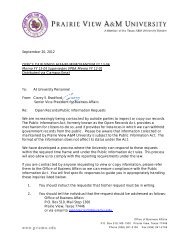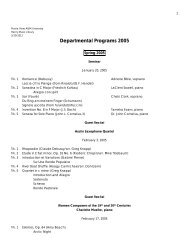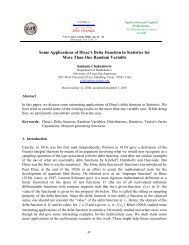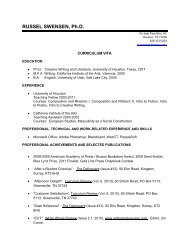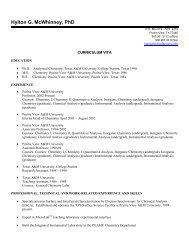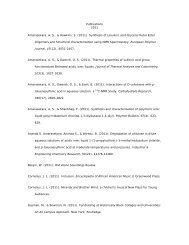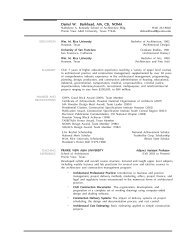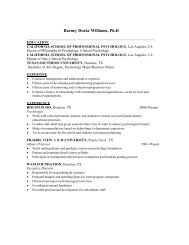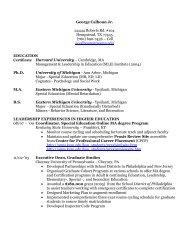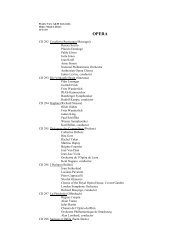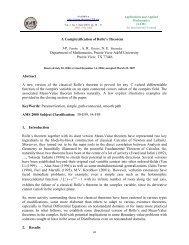Journal of History and Culture Journal of History and Culture
Journal of History and Culture Journal of History and Culture
Journal of History and Culture Journal of History and Culture
Create successful ePaper yourself
Turn your PDF publications into a flip-book with our unique Google optimized e-Paper software.
j o u r n a l o f h i s t o r y a n d c u l t u r e<br />
the second excavation revealed a grave shaft. The first anomaly that was excavated was <strong>of</strong>fset about 5 feet from the<br />
headstone <strong>of</strong> Milo Wilson, Jr., which appeared to be in situ. We suggest that there may have been a delay between the<br />
burial <strong>and</strong> the arrival <strong>of</strong> the grave marker, which led to the marker being placed slightly <strong>of</strong>f the actual burial location.<br />
The second anomaly that was excavated was located about 20 feet southeast <strong>of</strong> the first <strong>and</strong> was not associated with<br />
any surface marker. Most <strong>of</strong> the anomalies were located in the main clearing <strong>of</strong> the cemetery.<br />
Survey Layout<br />
In February 2008, additional GPR data were acquired at Wyatt Chapel Cemetery, along with magnetometer<br />
data. The main focus <strong>of</strong> this second data collection was to investigate a stratigraphic anomaly first identified on the<br />
2007 data (Figure 4). In particular, we wanted to establish the boundaries <strong>of</strong> this anomaly <strong>and</strong> try to identify its<br />
cause as either natural or anthropogenic. Prairie View A&M students <strong>and</strong> the city <strong>of</strong> Prairie View had worked to<br />
clear the brush from the main clearing at the cemetery <strong>and</strong> removed much <strong>of</strong> the trash from the area in an effort<br />
to help facilitate the gathering <strong>of</strong> data by the GPR team.<br />
The area <strong>of</strong> interest was identified based on the 2007 data. The main clearing that contains the excavated<br />
anomalies also shows a relatively deep stratigraphic anomaly. The real-time data display feature <strong>of</strong> the GPR system<br />
was used to locate the anomaly from the 2007 data <strong>and</strong> determine the best new site for data acquisition.<br />
A 2-D grid <strong>of</strong> GPR pr<strong>of</strong>iles was acquired in the main clearing (Figure 5). A rectangular plot 24 feet by 60<br />
feet was staked <strong>of</strong>f <strong>and</strong> squared, <strong>and</strong> the perimeter was defined with string. The coordinates <strong>of</strong> each corner <strong>of</strong> the<br />
plot was obtained with a Garmin GPSMAP 60 h<strong>and</strong>held GPS unit, with accuracy <strong>of</strong> about 13 feet. The area was<br />
cleared <strong>of</strong> overhanging brush <strong>and</strong> limbs so that the GPR cart could be pulled smoothly across the site without losing<br />
contact with the ground. Stakes were placed along the perimeter line at increments <strong>of</strong> 2 feet <strong>and</strong> a string line was<br />
placed between opposing stakes to ensure that each run was straight. The equipment was pushed along the string<br />
line from the same starting line in each direction so that the lines were consistently North to South <strong>and</strong> East to West.<br />
A total <strong>of</strong> 44 lines were acquired in the main clearing, with 13 North-South lines (Lines 1-13) perpendicular to 31<br />
East-West lines (Lines 14-44).<br />
All the data was acquired in one day, so the field conditions were constant. The data were processed using<br />
GSSI’s RADAN s<strong>of</strong>tware. Processing included adjusting time zero to the ground surface, converting the time sections<br />
to depth using a dielectric <strong>of</strong> 17, <strong>and</strong> applying a gain function. Data were interpreted in ArcGIS <strong>and</strong> Google Viewer.<br />
61




